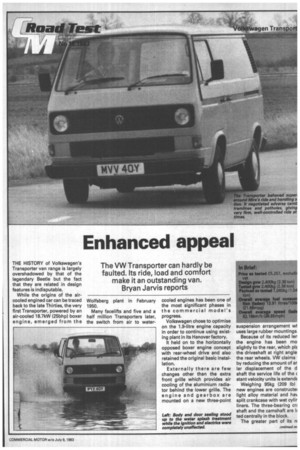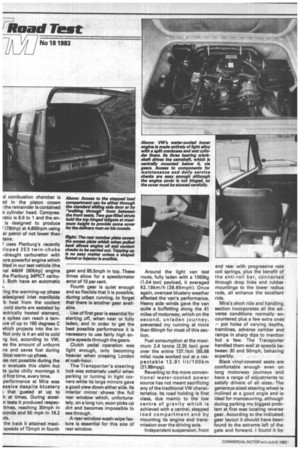Enhanced appeal
Page 47

Page 48

Page 49

If you've noticed an error in this article please click here to report it so we can fix it.
The VW Transporter can hardly be faulted. Its ride, load and comfort make it an outstanding van. Bryan Jarvis reports
THE HISTORY of Volkswagen's Transporter van range is largely overshadowed by that of the legendary Beetle but the fact that they are related in design features is indisputable.
While the origins of the aircooled engined car can be traced back to the late Thirties, the very first Transporter, powered by an air-cooled 18.7kW (25bhp) boxer engine, emerged from the Wolfsberg plant in February 1950.
Many facelifts and five and a half million Transporters later, the switch from air to water cooled engines has been one of the most significant phases in the commercial model's progress.
Volkswagen chose to optimise on the 1.9-litre engine capacity in order to continue using existing plant in its Hanover factory.
It held on to the horizontally opposed boxer engine concept with rear-wheel drive and also retained the original basic instal lation.
Externally there are few changes other than the extra front grille which provides air cooling of the aluminium radiator behind the lower grille. The engine and gearbox are mounted on a new three-point suspension arrangement wi uses large rubber mountings.
Because of its reduced ler the engine has been mo slightly to the rear, which pie the driveshaft at right angle the rear wheels. VW claims by reducing the amount of ar lar displacement of the d shaft the service life of the ( stant velocity units is extendE Weighing 95kg (209 lb) new engines are constructec light alloy material and hax, split crankcase with wet cylir liners. The three-bearing cri shaft and the camshaft are k ted centrally in the block.
The greater part of its r( I:1 combustion chamber is ?.d in the piston crown ! the remainder is contained e cylinder head. Compresratio is 8.6 to 1 and the enis designed to produce (78bhp) at 4,600rpm using ar petrol of not lower than tane.
f uses Pierburg's recently ;loped 2E3 twin-choke -draught carburettor with lore powerful engine which itted in our test vehicle (the nal 44kW (60bhp) engine the Pierburg 34PICT carbu). Both have an automatic t.
'ing the warming-up phase edesigned inlet manifolds .b heat from the coolant cold starts are assisted by ectrically heated element, e spikes can reach a ternure of up to 180 degrees C which projects into the inNot only is it an aid to cold eig but, according to VW, :es the amount of unburnt ire and saves fuel during itical warm-up phase.
as not possible during the o evaluate this claim but te quite chilly mornings it d first time, every time.
performance at Mira was essive despite blustery ; that gusted at up to Ii at times. During acceln tests it produced respectimes, reaching 30mph in tconds and 50 mph in 18.2 ,ds.
the track it attained maxispeeds of 72mph in fourth gear and 85.5mph in top. These times allow for a speedometer error of 10 per cent.
Fourth gear is quiet enough and so flexible that it is possible, during urban running, to forget that there is another gear available.
Use of first gear is essential for starting off, when near or fully laden, and in order to get the best possible performance it is necessary to use fairly high engine speeds through the gears.
Clutch pedal operation was light enough, only becoming heavier when crossing London at rush-hour.
The Transporter's steering lock was extremely useful when parking or turning in tight corners while its large mirrors gave a good view down either side. Its interior mirror shows the full rear window which, unfortunately, on a long run, soon picks up dirt and becomes impossible to see through.
A rear-window wash-wipe feature is essential for this size of rear window. Around the light van test route, fully laden with a 1060kg (1.04 ton) payload, it averaged 62.19km/h (38.65mph). Once again, overcast blustery weather affected the van's performance. Heavy side winds gave the van quite a buffetting along the 41 miles of motorway, which on the second, unladen journey, prevented my running at more than 60mph for most of this section.
Fuel consumption at the maximum 2.4 tonne (2.35 ton) gvw over the entire 137.1km (85.68 mile) route worked out at a respect able 12.91 lit/100km (21.88mpg).
Reverting to the more conventional water-cooled power source has not meant sacrificing any of the traditional VW characteristics. Its road holding is first class, due mainly to the low centre of gravity which is achieved with a central, stepped load compartment and by mounting its engine and transmission over the driving axle.
Independent suspension, front and rear with progressive rate coil springs, plus the benefit of the anti-roll bar, connected through drop links and rubber mountings to the lower radius rods, all enhance the excellent ride.
Mira's short ride and handling section incorporates all the adverse conditions normally encountered plus a few extra ones — pot holes of varying depths, tramlines, adverse camber and ramps in sharp dips to mention but a few. The Transporter handled them well at speeds between 30 and 50mph, behaving superbly.
Black vinyl-covered seats are comfortable enough even on long motorway journeys and have a range of adjustments to satisfy drivers of all sizes. The generous-sized steering wheel is inclined at a good angle and is ideal for manoeuvring, although during parking my biggest problem at first was locating reverse gear. According to the indicated gear layout it should have been found to the extreme left of the gate and forward. I found it by good fortune midway between there and second gear and soon adapted to its new position without any further hitch.
Summary By introducing the quieter, more environmentally acceptable water-cooled 1.9 litre, 44 and 57kW petrol engines to its Transporter range, VW hopes to enhance its appeal to industrialised countries as well as developing nations.
Although the van-bodied variants still give a noisy ride there is an improvement over previous air-cooled models, and the better payloads and greater pulling power are certain to stretch VW's competitors.




















































































